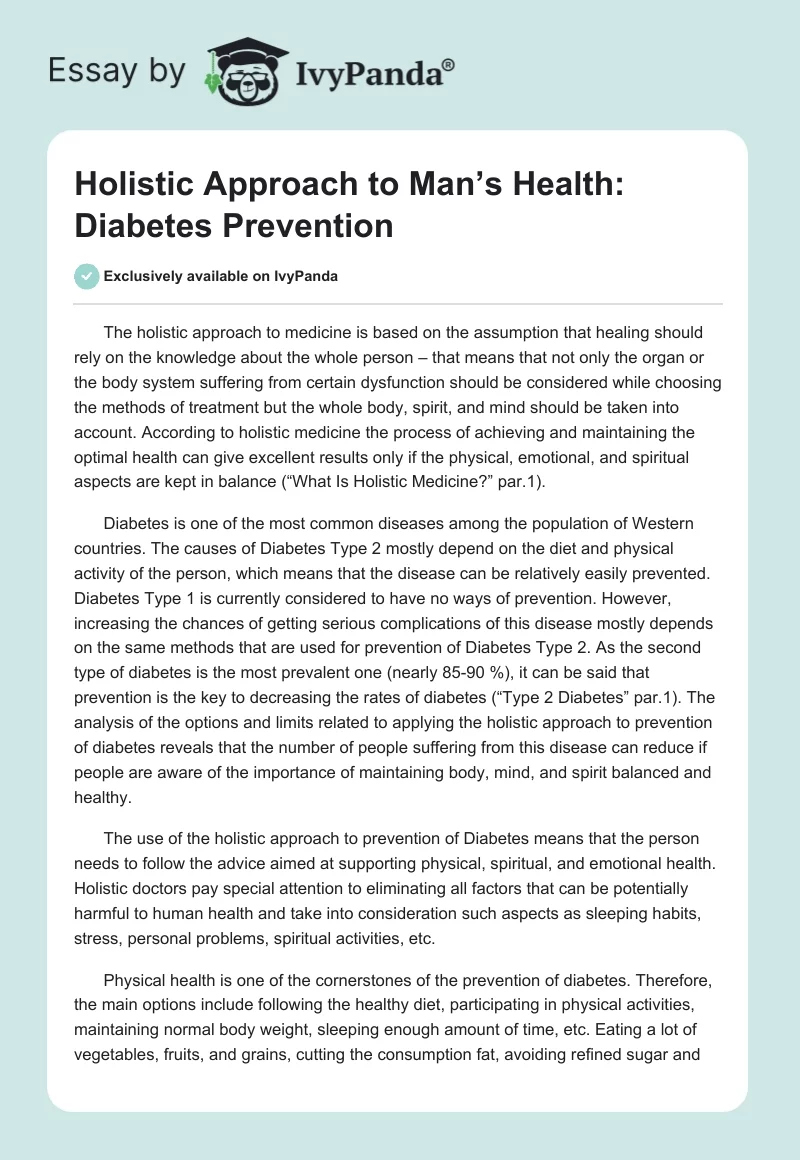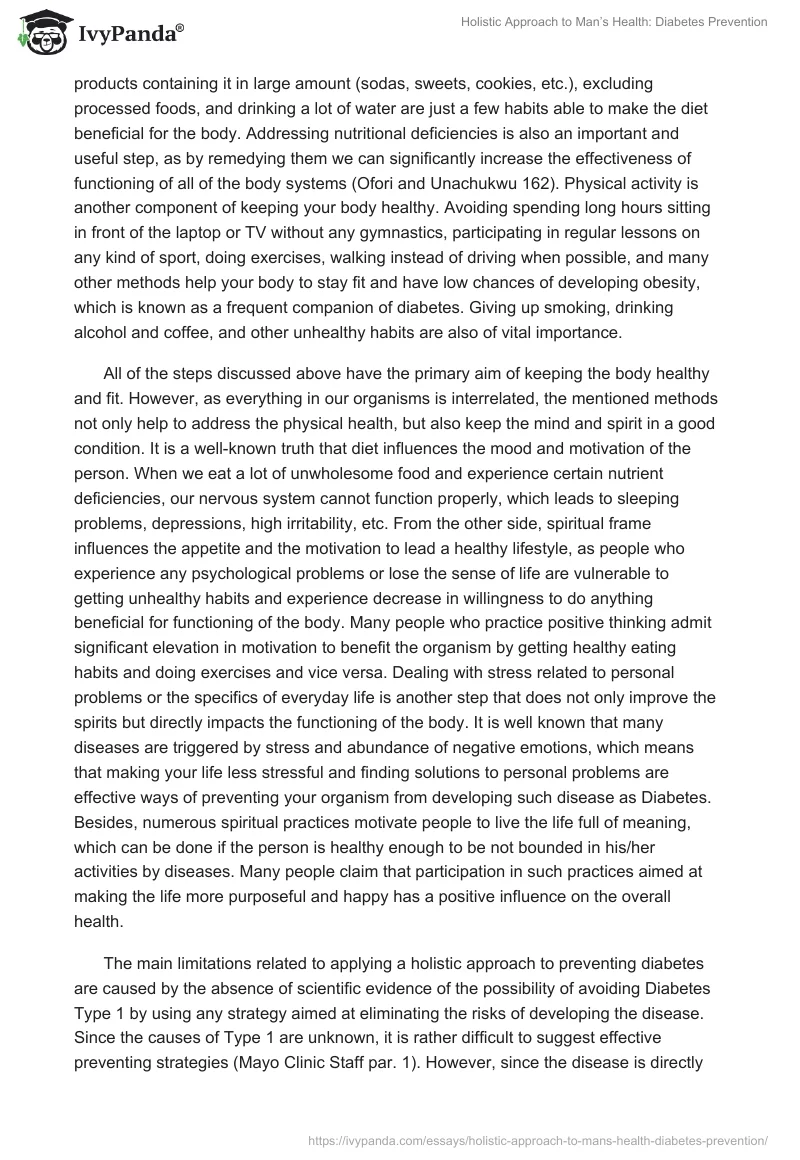The holistic approach to medicine is based on the assumption that healing should rely on the knowledge about the whole person – that means that not only the organ or the body system suffering from certain dysfunction should be considered while choosing the methods of treatment but the whole body, spirit, and mind should be taken into account. According to holistic medicine the process of achieving and maintaining the optimal health can give excellent results only if the physical, emotional, and spiritual aspects are kept in balance (“What Is Holistic Medicine?” par.1).
Diabetes is one of the most common diseases among the population of Western countries. The causes of Diabetes Type 2 mostly depend on the diet and physical activity of the person, which means that the disease can be relatively easily prevented. Diabetes Type 1 is currently considered to have no ways of prevention. However, increasing the chances of getting serious complications of this disease mostly depends on the same methods that are used for prevention of Diabetes Type 2. As the second type of diabetes is the most prevalent one (nearly 85-90 %), it can be said that prevention is the key to decreasing the rates of diabetes (“Type 2 Diabetes” par.1). The analysis of the options and limits related to applying the holistic approach to prevention of diabetes reveals that the number of people suffering from this disease can reduce if people are aware of the importance of maintaining body, mind, and spirit balanced and healthy.
The use of the holistic approach to prevention of Diabetes means that the person needs to follow the advice aimed at supporting physical, spiritual, and emotional health. Holistic doctors pay special attention to eliminating all factors that can be potentially harmful to human health and take into consideration such aspects as sleeping habits, stress, personal problems, spiritual activities, etc.
Physical health is one of the cornerstones of the prevention of diabetes. Therefore, the main options include following the healthy diet, participating in physical activities, maintaining normal body weight, sleeping enough amount of time, etc. Eating a lot of vegetables, fruits, and grains, cutting the consumption fat, avoiding refined sugar and products containing it in large amount (sodas, sweets, cookies, etc.), excluding processed foods, and drinking a lot of water are just a few habits able to make the diet beneficial for the body. Addressing nutritional deficiencies is also an important and useful step, as by remedying them we can significantly increase the effectiveness of functioning of all of the body systems (Ofori and Unachukwu 162). Physical activity is another component of keeping your body healthy. Avoiding spending long hours sitting in front of the laptop or TV without any gymnastics, participating in regular lessons on any kind of sport, doing exercises, walking instead of driving when possible, and many other methods help your body to stay fit and have low chances of developing obesity, which is known as a frequent companion of diabetes. Giving up smoking, drinking alcohol and coffee, and other unhealthy habits are also of vital importance.
All of the steps discussed above have the primary aim of keeping the body healthy and fit. However, as everything in our organisms is interrelated, the mentioned methods not only help to address the physical health, but also keep the mind and spirit in a good condition. It is a well-known truth that diet influences the mood and motivation of the person. When we eat a lot of unwholesome food and experience certain nutrient deficiencies, our nervous system cannot function properly, which leads to sleeping problems, depressions, high irritability, etc. From the other side, spiritual frame influences the appetite and the motivation to lead a healthy lifestyle, as people who experience any psychological problems or lose the sense of life are vulnerable to getting unhealthy habits and experience decrease in willingness to do anything beneficial for functioning of the body. Many people who practice positive thinking admit significant elevation in motivation to benefit the organism by getting healthy eating habits and doing exercises and vice versa. Dealing with stress related to personal problems or the specifics of everyday life is another step that does not only improve the spirits but directly impacts the functioning of the body. It is well known that many diseases are triggered by stress and abundance of negative emotions, which means that making your life less stressful and finding solutions to personal problems are effective ways of preventing your organism from developing such disease as Diabetes. Besides, numerous spiritual practices motivate people to live the life full of meaning, which can be done if the person is healthy enough to be not bounded in his/her activities by diseases. Many people claim that participation in such practices aimed at making the life more purposeful and happy has a positive influence on the overall health.
The main limitations related to applying a holistic approach to preventing diabetes are caused by the absence of scientific evidence of the possibility of avoiding Diabetes Type 1 by using any strategy aimed at eliminating the risks of developing the disease. Since the causes of Type 1 are unknown, it is rather difficult to suggest effective preventing strategies (Mayo Clinic Staff par. 1). However, since the disease is directly associated with the pancreases dysfunction, prevention of pancreatic problems through avoiding intake of chemical and drugs destroying pancreatic cells can be considered the possible way of contributing to preventing Type 1 Diabetes.
The severity of the complications caused by diabetes appears to be directly related to the general health of the organism. For example, the hypoglycemia unawareness, which is a syndrome seriously threatening the safety of patients suffering from Diabetes, appears to be directly related to the quality of brain function, as most hypothesis about the causes of the syndrome are based on the assumption that it has neurobiological origin (e.g. The brain fuel hypothesis, The brain neuronal communication hypothesis) (Martin-Timon and Canizo-Gomez 915). This fact illustrates the importance of applying the holistic approach to eliminating the manifestations of diabetes through revealing the interrelation between different body systems.
The process of reversing Diabetes is mostly effective for Type 2 and includes the basic rules that need to be followed for its prevention. The tendencies of relying on the holistic treatment of the body instead of taking regular medicines and insulin injections can be seen worldwide (Brown-Riggs 28). More and more people suffering from Diabetes Type 2 choose the combination of healthy diet, physical activity, and spiritual well-being as the alternative way of treating and reversing the disease and getting amazing results.
The analysis of the main options for preventing diabetes by applying the holistic approach to medicine reveals that though Type 1 Diabetes appears to have no ways of prevention, Type 2 Diabetes can be easily avoided by leading the lifestyle based on keeping the balance between the well-being of body, mind, and spirit. Moreover, the same strategy can be used for reversing the disease, as the experience of millions of people worldwide demonstrates.
References
Brown-Riggs, Constance. “Reversing Type 2 Diabetes with Natural Therapies.” Today’s Dietitian 14.11 (2012): 28. Print.
Martin-Timon, Iciar, and Francisco Javier del Canizo-Gomez. “Mechanisms of Hypoglycemia Unawareness and Implications in Diabetic Patients.” World Journal of Diabetes 6.7 (2010): 912-926. Print.
Ofori, Sandra, and Chioma Unachukwu. “Holistic Approach to Prevention and Management of Type 2 Diabetes Mellitus in a Family Setting.” Diabetes, Metabolic Syndrome and Obesity: Targets and Therapy 7 (2014): 169-168. Print.
Mayo Clinic Staff. Type 1 Diabetes: Causes. 2012. Web.
Type 2 Diabetes. n.d. Web.
What Is Holistic Medicine?n.d. Web.


